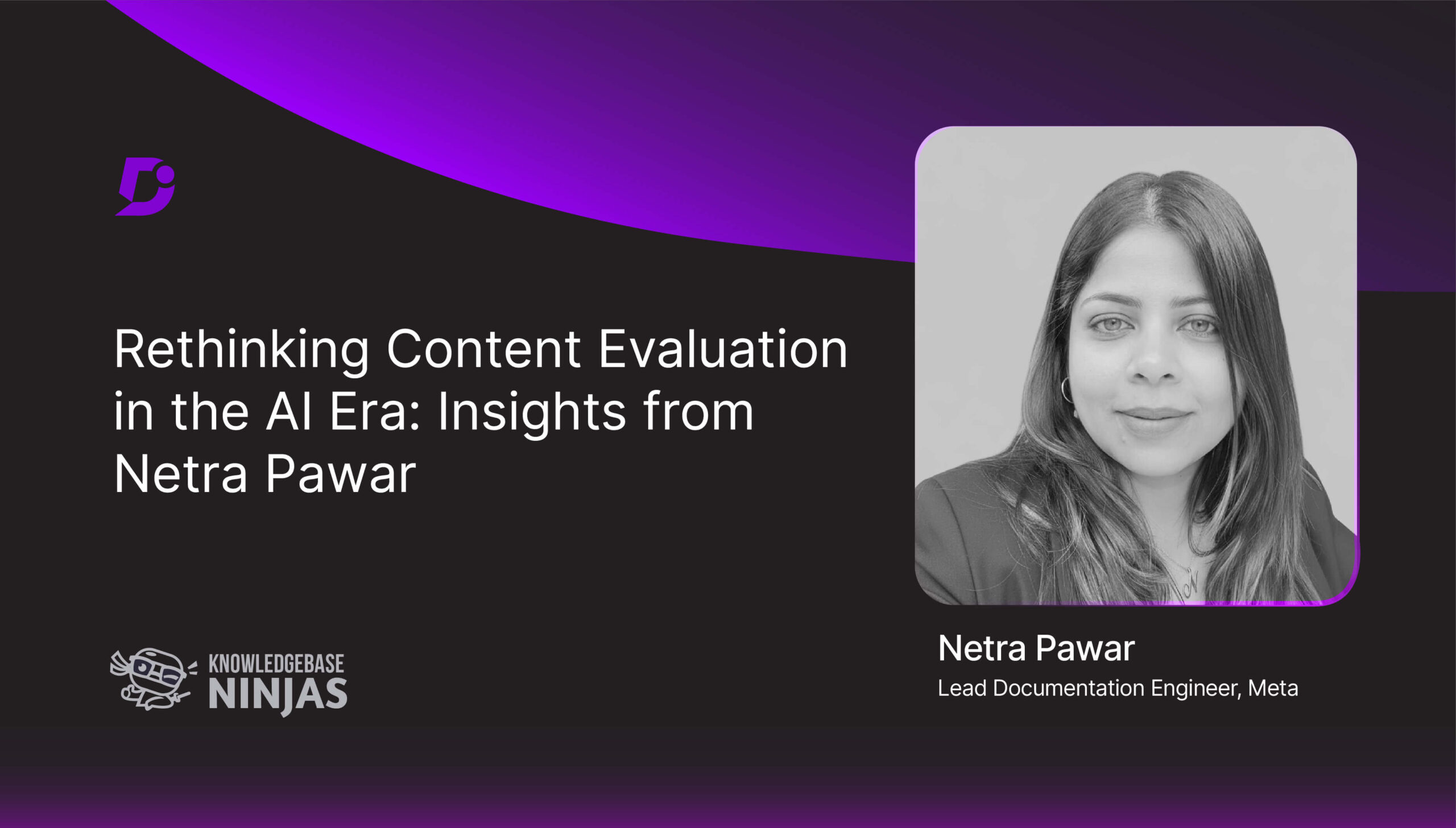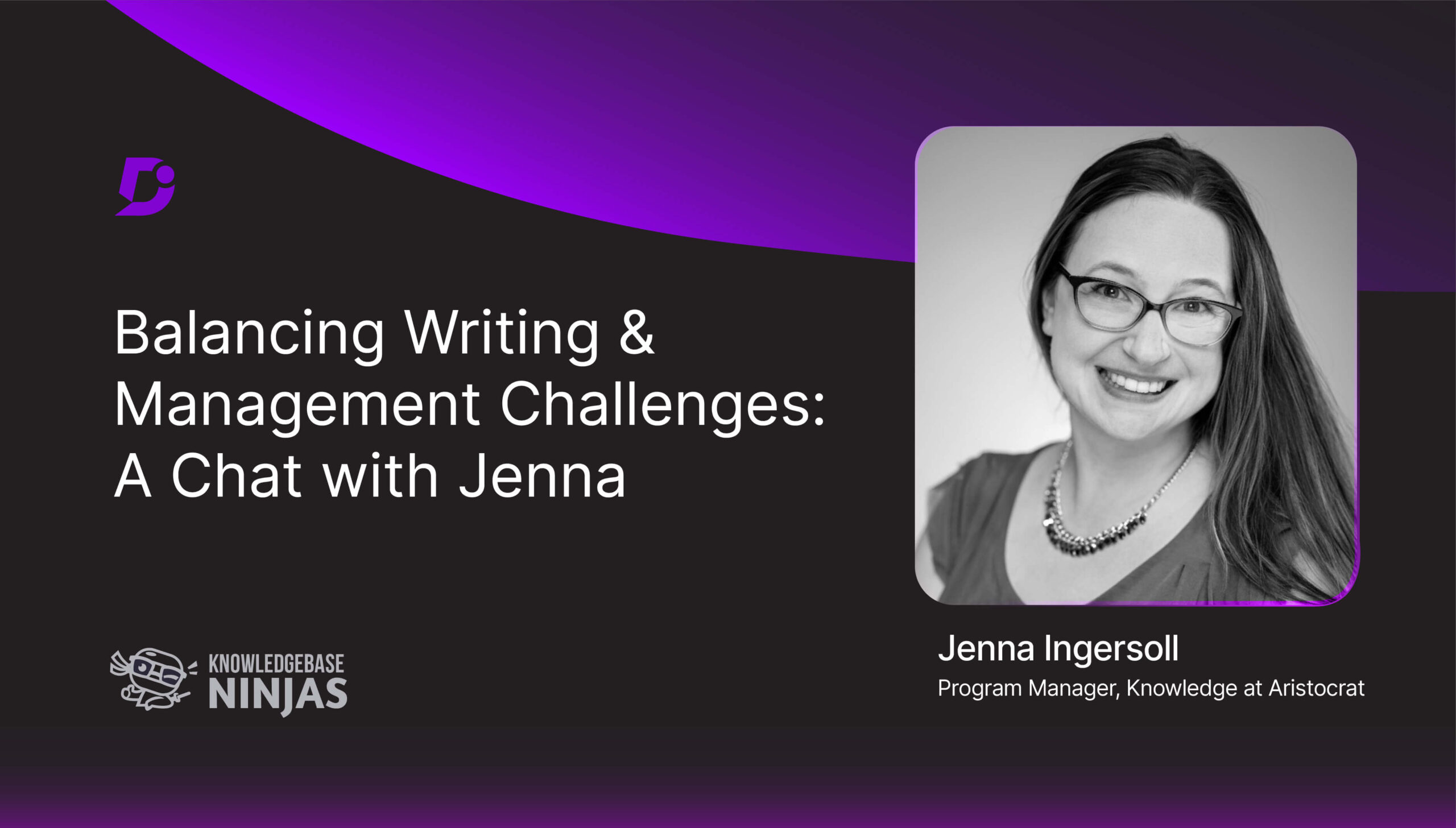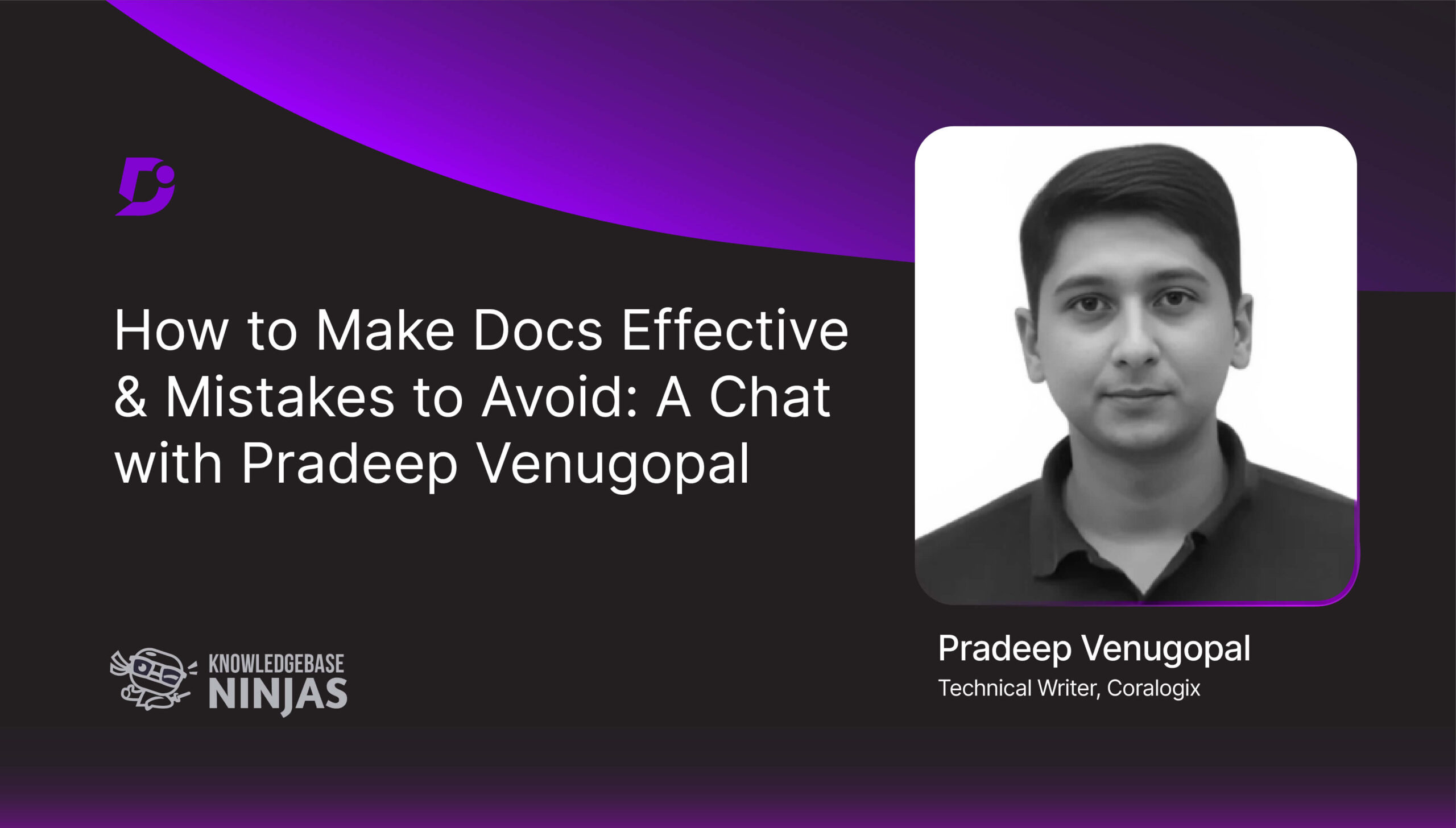In this episode of the Knowledge Base Ninjas podcast, Jason talks about how AI is transforming the day-to-day work of technical writers. He explains that while AI tools can help with drafting, applying style guides, and automating repetitive tasks, their real value lies in improving productivity and freeing up time for more meaningful work. He shares examples of using AI to enforce writing standards and streamline editing, allowing writers to focus on higher-level collaboration and mentorship. He emphasizes that AI still struggles with accuracy and nuance, especially when it comes to producing high-quality, reliable documentation. Human review and intervention remain essential to ensure clarity and correctness. He also talks about choosing or integrating AI tools into existing workflows and a lot more.
Watch the full podcast episode video here
You can listen to the full episode on Apple, Spotify and YouTube.
About Jason
-
Jason’s LinkedIn
-
Jason Christie is the Senior Technical Writer Lead at Shopify, and his journey into technical writing was not a planned move. Coming from an academic background, he soon realized that path wasn’t the right fit for him and discovered a new direction in technical writing. What began as a contract role quickly turned into a fulfilling career where he found room to grow and be part of a strong community of writers. Today, Jason brings his academic precision and curiosity to the craft, creating documentation that informs and empowers users.
Quick jumps to what’s covered:
2:24 – How Shopify Uses AI in Technical Writing
6:05 – Automating Style Guide and Editing with AI
7:49 – Using AI Tools like MCP Servers and Slack Integration
11:25 – Limitations of AI in Documentation
14:55 – Evaluating and Selecting AI Tools at Shopify
16:41 – Integrating AI with Existing Documentation Systems
Transcript:
-
-
01:08 – 02:26 Jason’s Journey into Technical Writing
Gowri Ramkumar: Hi! Welcome everyone to the Knowledge Base Ninjas podcast. With me today, we’ve got Jason Christie, Senior Technical Writer Lead at Shopify.
Hi, Jason. How are you doing?
Jason Christie: Hello. It’s nice to see you again. I’m doing very well. How are you?
Gowri Ramkumar: Thank you. Thank you so much for coming again and helping us with your thoughts on the latest technology and trends.
So just to recap, how did you get into this career, and how is it going so far for you?
Jason Christie: I hope it’s going well. It still feels like it is.
I got into the career in a way that seems typical from all the interviews I’ve done with technical writers over the years. Which is I didn’t start out thinking I would be a technical writer. I started as an academic. But I realized that wasn’t necessarily for me, and I started looking around. I answered an ad and started working as a contractor, as a technical writer, and found that there was plenty of room to grow and plenty of opportunity there. So, it sort of made me aware that there was a full career and community, and that there was a craft out there that I could apply all of the skills I had developed in the Academy, and bring them to bear on the work as a technical writer.
Gowri Ramkumar: Right. Super. Thank you so much.
-
02:26 – 09:09 Integrating AI into Documentation Workflows
Gowri Ramkumar: And, I’m going to straightaway start with AI because we’ve spoken quite a lot about your other parts in the previous conversation.
So I know everybody’s now trying to see how to use AI and how to make it more effective and productive, right? So now, from your perspective, how do you currently see AI fitting into your day-to-day work as a technical writer?
Jason Christie: Yeah, AI, it’s a great question. I think we could fill several podcasts with this topic.
So I think it’s no secret at this point that Shopify is very excited about AI, and the company is encouraging every single person in management. And, I see roles to use AI reflexively in their day-to-day work.
And so, on the technical writing team, we very quickly realized, you know, that we had to innovate and use AI to figure out how to do our job differently. The, so what we realized was getting a step beyond just that AI can rewrite documentation or AI can provide drafts of things. We started to dig really deep into the tooling and look for ways that we could have AI help us scale and increase our capacity and do more. And we’re seeing lots and lots of interesting results there. So I think it’s a massive opportunity.
Very early on, one of the first things we did was use AI to apply our style guide rules. And so we built a rule set and a resource that AI could use, and we integrated that into, we were using VS Code at the time. And so it became sort of a linter for us in that sense. Providing a little bit more than just a squiggly underline to say that word is wrong or there’s a violation.
Gowri Ramkumar: Yeah.
Jason Christie: So it became sort of like an always-on editor in your pocket who could help you to rephrase things to use, to rewrite things, but also to apply the style guide rules.
Gowri Ramkumar: Yeah.
Jason Christie: And the style guide has always been a tricky one, is something that when people start, they read it and they diligently follow it and they refer back to it. But then, 3-4 years into a rule, you know, it’s bookmarked, but they never go and look. So it becomes sort of natural.
Gowri Ramkumar: Yeah.
Jason Christie: And for the editing team, it becomes a game of sort of, you know, you always do this. You always, you know, underline the if then construction, for example, was when I struggled with a lot. And so this reduces the burden on the editorial team to catch all those tiny, minor infractions that slip in over time as you start to forget what’s in the style guide and not refer to it regularly. So it was very powerful for that. And then we could kind of repurpose our editors to help new team members or technical writers early in their career in more one-on-one, hands-on ways, and so less time catching the minutiae and more time using their skills and expertise in more productive ways. Which is really great.
And then more recently, we’ve sort of accelerated in how we’re using AI and exploring what AI can do. I don’t know if you’ve heard of MCP servers, Model Context Protocol servers.
Gowri Ramkumar: No, no.
Jason Christie: Yeah.
They’re basically ways that you can create tooling that can be called into AI applications or assistants. And so, you could imagine, the one that we use a lot is the, there’s a data portal, multi-context. I’m gonna get this wrong, MCP server.
Gowri Ramkumar: Okay.
Jason Christie: And so what this does is it allows you to, in natural language, run queries against your data and ask questions about your data.
Gowri Ramkumar: Alright.
Jason Christie: And so you could see immediately how that would be super powerful. You don’t have to go into BigQuery. You don’t have to go into Looker Studio. You don’t have to know SQL.
Gowri Ramkumar: Yeah.
Jason Christie: You can just ask, and so that’s been really kind of powerful and eye-opening. And the applications obviously are, you know, you can connect to your customer support data and say, give me the trending topics. And then you can sort of query your content set and say, do we have content that covers these topics?
And, you know, AI can do a kind of analysis of that and provide some results. But, because it’s AI, you have to check it. You can’t just…
Gowri Ramkumar: Human in the loop. Yeah.
Jason Christie: Absolutely. And so, you know, you can’t necessarily, confidently trust the data immediately. You have to verify, and then you have to, you know, look at the analysis of the content and kind of use your own insight, and then intervene in ways that makes sense to you. You can’t just sort of copy and paste or assume that the AI will run it and update the content effectively.
So, but what it does do is, it means like, you don’t have to go to a data scientist and say, you know, I need to know, can you give me the top ten topics that are trending and support?
Gowri Ramkumar: Yeah.
Jason Christie: The poor data scientists, you know, are getting questions like that from hundreds of people. And so with the tooling like this, you know, you’re reducing that burden on them and they can focus on more high-priority and urgent and, probably, more interesting matters they need to figure out. And so we’re also seeing some interesting success integrating with our communications tool, using Slack.
Gowri Ramkumar: Okay.
Jason Christie: What we are hearing from people is that there is, like, a fatigue from being remote and being in Slack, constantly monitoring the channels and conversations and trying to keep up with that flood of information to find the kernels of data that you need to do the updates, that you need to do to your documentation, the decisions that get made and threads that you don’t see. And so there’s a lot of pressure and a lot of worry about missing something in there.
By connecting AI to Slack and running it in some kind of assistant, you can just get a digest or a summary, and it can tell you the action items that are relating to content development for you. So it’s pretty powerful that way. You know, every hour you could run it, if it’s a busy Slack channel, or once a day at the end, or the beginning and end of your day, you could say, summarize the discussions in this channel, identify the key players. You know, list the decisions that were made. It’s pretty powerful for that.
And in this way, like, these are revolutionary ideas, but they do return time back to your day and in small amounts that aggregate up to, I think, like a pretty big savings overall.
Gowri Ramkumar: Yeah.
Jason Christie: And it reduces some of the rest or the most frustrating parts of the job.
Gowri Ramkumar: So. Right. Yeah.
It’s like not only in your area, but across the company, there’s a lot of AI-related innovations and usages happening, which is great to know.
-
09:09 – 12:28 Why Human Touch Still Matters in Docs
Gowri Ramkumar: Now you spoke about the usage of AI giving, if not a lot, at least some time back to you to do a lot more productive work, right?
Now, at the same time, there could be some parts, or in the documentation process, with AI still struggles or falls short. Have you come across any such scenarios yet?
Jason Christie: Yes. Yeah.
I think it’s funny because I remember when ChatGPT first kind of blew up and everyone got excited about it. It was like, oh, no one will ever have to write again. Writing is done. And we all thought, okay, like what? What does that mean for people who are technical writers, for example?
Gowri Ramkumar: Yeah.
Jason Christie: That’s kind of a scary proposition. But here we are, sort of many, many months into this now, and it’s clear that it still can’t write well enough. And, it can’t generate technical documentation accurately enough to be trusted. And so, I think that’s where, you know, the technical writers who can kind of adapt and embrace the sort of AI tooling available can really make a difference. Because maybe you’re getting drafts out of your project management tool, say, leading up to a release or a version. Instead of combing through it yourself to, like, pick apart every little detail, you know, you could just have, like, we have the linter run on it to apply the style guide.
We have some content analysis that can be done by the AI assistant to help you sort through all of that information. Kind of focus on what’s critical for the release or version, and pull all that information out into a document that you can then use as your basis for the update, you have to do.
Gowri Ramkumar: Alright.
Jason Christie: So I think that’s really interesting. But what we’re definitely seeing is that, like, it doesn’t generate good writing well enough to satisfy the sort of like, production-ready, sort of editorial process, like, it’s still always needs to be cleaned up, facts checked. It’s still wrong a lot of the time. And I think, you know, like, that’s the part where it really needs a human hand to be there. And I think depending on the size of the company and speed of development and activity, it could be a lot of content that gets generated by AI in this kind of system.
Gowri Ramkumar: Yeah.
Jason Christie: So I think, you know, at the beginning we thought it might mean fewer technical writers. It might mean, writing less. But what I think is actually happening is that it’s requiring the skills and expertise of technical writers more than ever, to make sure that it’s accurate, to make sure that it’s up to date.
You know, you can try to make a system as perfect as possible, but wherever it integrates with humans, it’s going to be messy. It’s going to be a little chaotic. The fields won’t be filled incorrectly. You know what I mean? So I think if you have that messy human input coming into the system, no matter how good the system is…
Gowri Ramkumar: Yeah.
Jason Christie: You’re always going to need humans to verify and to organize and to make sure it’s perfect for your customers on the other end and for your audience.
Gowri Ramkumar: Very true, very true. I think, even if it’s like that accurate, it’s always have a human to verify before it goes out to consumers. Absolutely right, Jason.
-
12:28 – 14:14 Choosing the Right AI Tools for Documentation
Gowri Ramkumar: You also spoke about a lot of the AI tools, right? Now, how do you evaluate your tools before introducing to the team? Some key factors that you consider?
Jason Christie: Yeah, I think, you know, again, I feel very fortunate to be at Shopify, where we have access to a lot of AI tools. And so a lot of that, trial and error, and testing is being done across the company. Really. And so we can kind of cherry-pick the best pieces and bring them into our team. Really, what we look for is, you know, how flexible the tooling is, like, can it do more than one thing?
A great example of this would be Cursor, our code editor.
Gowri Ramkumar: Yeah.
Jason Christie: And so, as soon as we saw the potential for what Cursor could do and how it integrates with all of our systems and gives you that sort of AI assistant with the many models available right in your code editor, it made sense to immediately switch. And that’s where a lot of our experimentation is happening, and innovation on our processes and workflows. So, yeah, we definitely moved quickly on that one.
I think the other piece, we’ve touched on this a few times, but it’s the accuracy.
Gowri Ramkumar: Yep.
Jason Christie: And so the team has been great at sort of determining and figuring out, like, which AI models or which LLMs make the most sense for which tasks.
Gowri Ramkumar: Alright.
Jason Christie: And that’s been a process of trial and error. And, just working with the different models to try to understand what their strengths and weaknesses are.
Gowri Ramkumar: Yeah.
Jason Christie: So I think, you know, it’s not, there’s not any sort of strict evaluation that happens. It’s more, you know, we have access to them. We try them to see what they can do for us, and then if they’re great, if they give us some kind of advantage, will adopt them pretty quickly and see what we can do.
Gowri Ramkumar: Right.
-
14:14 – 16:16 How Shopify Unified Its Docs Workflow with AI and Cursor
Gowri Ramkumar: Again, you again touch based on that topic very briefly, how do you integrate AI with existing documentation tools like, you mentioned in the beginning of the conversation, you use AI for creating style guides, so it checks the content.
So apart from that, how do you make sure that the AI is integrated well with your existing tools?
Jason Christie: That’s, yeah, that’s the tricky part.
You know, prior to using Cursor, we had sort of one off tools we would use, like an internal AI chatbot that we could load models into, and we could have custom prompts for it, and we could use that to, you know, revise documentation or do some analysis. We were using NotebookLM for a little bit for, that kind of analysis where you drop in a bunch of resources and it can kind of generate ideas or updates for you. And it was sort of like all over the place. So it wasn’t well integrated. It was, you know, a folder on your bookmarks bar full of tools that you could use theoretically to do work. And that was okay.
And then Cursor came along. And Cursor really was the piece that neatly integrated our processes and workflows with the AI tooling that’s available. So we created rule sets in Cursor that applied our style guide, for example. We still use docs as code workflow. So, Git and GitHub, that all integrates quite neatly with Cursor, obviously.
And then with the MCP servers I mentioned earlier, like they’re all, can be brought into the Cursor environment as well. And you can leverage them there.
Gowri Ramkumar: Alright.
Jason Christie: So Cursor became like a really critical part of our tooling stack and quite powerful for that reason. And so yeah, I would say like once we got Cursor rolled out to the team, that’s really when things kind of took off and the possibilities opened up for what we could do with AI more broadly.
Gowri Ramkumar: Yeah. Alright.
-
16:16 – 19:00 ⚡Rapid Fire Round
Gowri Ramkumar: So now moving on to the Rapid Fire round questions, I’m sure you must have read a lot of resources. Anything in particular that you’d like to recommend?
Jason Christie: Yeah, I still, go back to The Product is Docs, like, all the time. It’s a book by Christopher Gales and the Splunk Documentation Team. It’s like dog-eared. I’ve read it. I’ve underlined things. It’s, you know, I might have to buy a new copy. But I find that a very valuable book. Especially when, you know, people join the team and kind of want to understand, like, what our ethos is and how we approach documentation.
Gowri Ramkumar: Yeah.
Jason Christie: That’s super useful, super powerful. And then, you know, last time I was on here, I think I said the same thing. It’s still true. Tom Johnson’s blog.
Gowri Ramkumar: Yeah.
Jason Christie: I’d Rather Be Writing. Yeah. Like a regular reader of that. The team they’re sharing articles and blog posts that Tom creates all the time. So I think that’s also a valuable resource for people.
If anybody shows any interest in the team, we also recommend, there’s a technical writing course that Google put together for developers. It’s been great for introducing people to the world of technical writing and getting them kind of caught up quickly. So I would also recommend that for anybody who’s interested in technical writing and hasn’t maybe, you know, secured a role or gotten it, gotten access to learning about technical writing yet.
Gowri Ramkumar: Alright.
Now, one word that comes to your mind when you hear “Documentation”?
Jason Christie: I think I really like the word Fidelity.
You know, I think it’s important that your documentation matches the products and services that are being offered, and so, you know, it’s a fine line, I think, between like documenting the product and marketing the product.
And so, you know, it’s important to make sure that you’re not documenting something that doesn’t exist yet or hasn’t been released or is hopeful and stay focused on you know, what actually exists. Because that’s what your audience and your customers need is, they need to know, you know, exactly what you’re offering, so.
Gowri Ramkumar: Absolutely, absolutely. And that’s why they raise those support tickets as well, right? So…
Jason Christie: Yeah.
Gowri Ramkumar: Very well said.
A piece of advice you would give to your 20-year-old self?
Jason Christie: It took me a long time to figure out that conferences exist. And, are amazing places to meet other technical writers and to, you know, greatly accelerate knowledge of the technical writing craft. So I would say, you know, start going to conferences early and meet in more technical writers early.
Gowri Ramkumar: Alright.
Super, now Jason, again, it was a pleasure connecting with you. And, unlike the previous time today, we’ve had lot more to discuss. And, you were, as usual, giving a lot of valuable insights with the long explanation.
-
19:00 – 21:04 Why Tech Writers Should Dive into AI Now
Gowri Ramkumar: So, anything else you would like to add?
Jason Christie: I would say, if you’re not already doing it, learn about AI. Jump in with both feet. You know, see what you can do. It’s a very exciting time because things are still so brand new. And even though it’s been a few years now, we’re still figuring out the applications for AI and it’s not what everyone thought.
It’s not that it can write or it can spellcheck or it can create presentations. It can do all of those things. But, if you bring it into your sort of day-to-day a lot more directly, I think it can reveal, like, all kinds of capacity and, and you can scale some of the parts of the job that you find frustrating or, you know, annoying, or finding success with batch resolving the sort of like, low hanging fruit issues that are easy to solve.
So if there’s enough information in the GitHub issue, we can just grab, you know, maybe 10, 20, 30, 40 issues and the AI assistant can process those pretty reliably. So, previously that was something that it was like deprioritized, because everyone is so busy and it just couldn’t get to it and your backlog would grow.
Gowri Ramkumar: Yeah.
Jason Christie: But that’s an example of where, at scale you can use AI to do things that, you know, aren’t that exciting for everyone. Yeah.
Gowri Ramkumar: Yeah. Yeah. So thank you so much. And I’m sure you’ve got lots to accomplish in the upcoming months, and all the very best for your project, and future engagement.
And, once again, thank you so much for being on the show again. Appreciate your support towards the community.
Jason Christie: It was a pleasure to be here. And, a big fan of Knowledge Base Ninjas and Documentar360. So thank you very much for having me.
Gowri Ramkumar: Thank you, Jason. Have a good day. Bye!
-
16:33 – 18:17 Essential Skills for Modern Technical Writing Careers
Gowri Ramkumar: Now, did I miss anything that you would like to share?
Pradeep Venugopal: I probably think for the next generation of technical writers. I think because of the, like I’ve heard, there’s a lot of fear of AI and everything.
I think AI literacy is important. So it’s just a tool that we can use and know how to leverage effectively while maintaining quality and then collaboration skills, working closely with product, engineering, and support, because people skills it’s utmost important as a technical writer because you’re dealing with a lot of people. But getting out and then comes probably your tool fluency and analytical and data literacy on how to, they need to learn how to use metrics to improve docs.
Once you have all of this in place and once you’re a technical writer for a long time, your content strategy and information architecture, so I think it should come naturally to you once you understand and have empathy for the product and the people using it.
Gowri Ramkumar: Right. Right.
Pradeep Venugopal: So Pradeep, that was an amazing conversation we had now. And, thank you for sharing all the nitty gritties of how you started your journey and what you accomplished in the last ten plus years. And, we wish you all the very best for your upcoming projects. And, good luck with a lot more innovations that’s yet to be experienced.
Pradeep Venugopal: Thank you so much.
And those were interesting questions, and I hope it reaches a lot of people.
Gowri Ramkumar: Absolutely.
Pradeep Venugopal: Thank you.
Gowri Ramkumar: Thank you so much. Take care, Pradeep.
Pradeep Venugopal: You too. Thank you.
Gowri Ramkumar: Bye-bye!
-
Disclaimer: This transcript was generated using AI. While we aim for high accuracy, there may be minor errors or slight timestamp mismatches.
Enjoyed this conversation?
Don’t miss listening to other episodes of our Knowledgebase Ninjas Podcast, where we invite documentation experts from all walks of the industry to share practical, real-world insights, experiences, and best practices. Subscribe for the latest episodes, and if you found this helpful, pass it to your colleagues!
Read Our eBook
Discover how AI is shaping the future of technical writing:
The Future of Technical Writing – AI’s Impact on Knowledge Management
Watch Webinars
Learn from experts and product specialists in our Webinar Library
Explore Case Studies
See how leading teams are using Document360 to build powerful knowledge bases: Customer Success Stories
Browse Resources
Access our full Resource Library — including blogs, videos, guides, and more
Try Document360 for Free
Experience how top teams create world-class documentation with ease.
Start Your Free Trial
Follow Us for Updates, Tips & Best Practices
LinkedIn | Twitter (X) | Facebook | Instagram | YouTube

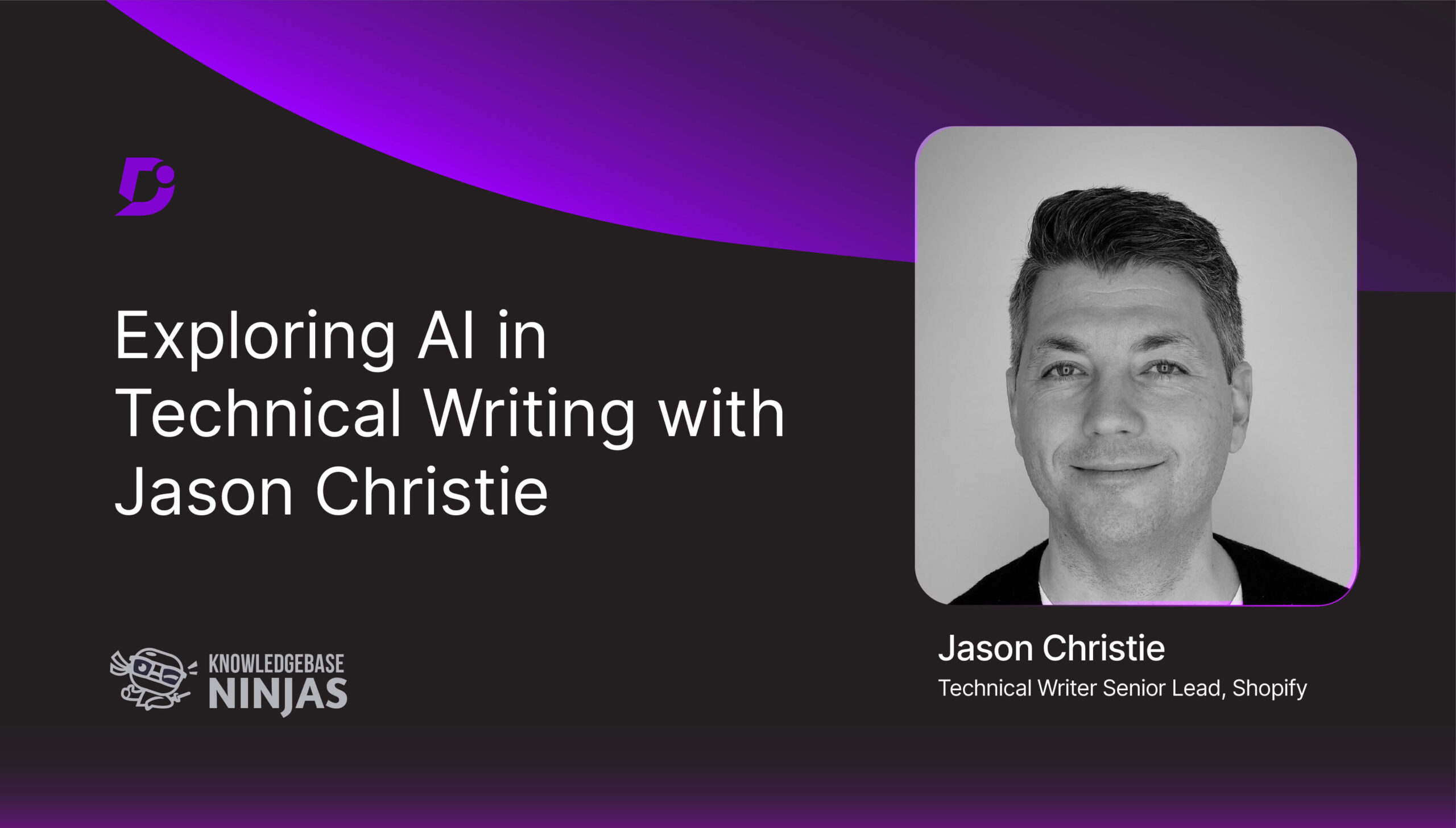
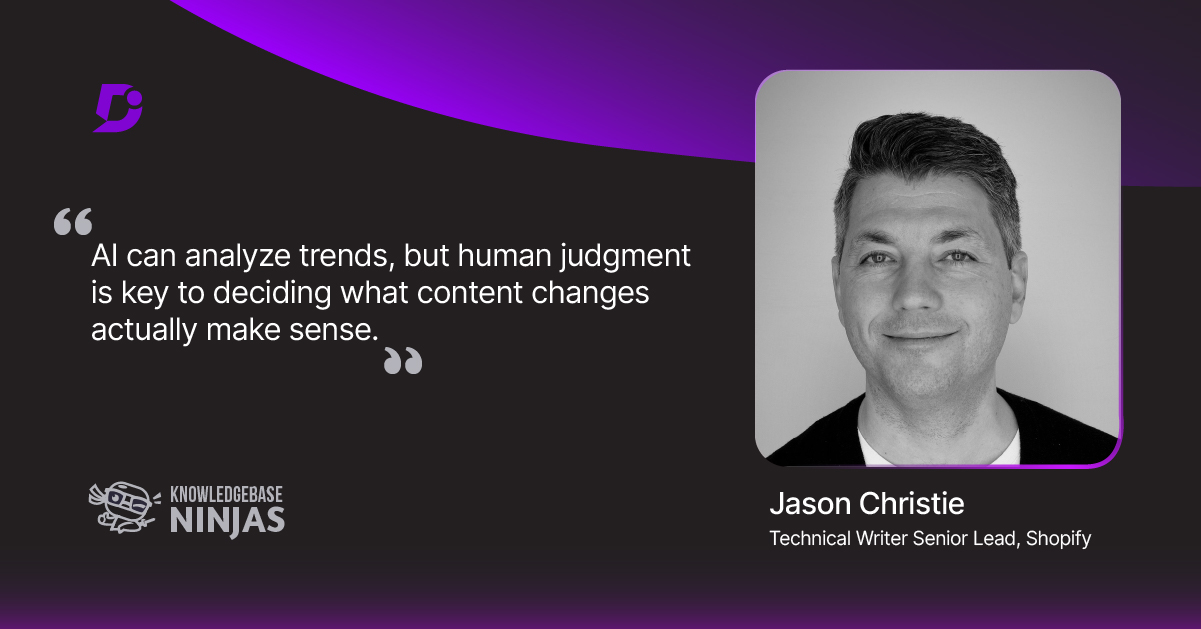



 –
– 